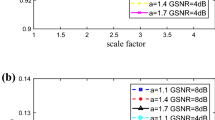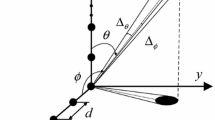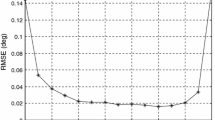Abstract
By applying the covariation statistics, this paper generalizes the non-circularity to the scenario of complex isotropic symmetric alpha-stable (\( S\alpha S \)) signals. The matrices based on fractional lower order moments for the extended sensor array outputs, which have been shown to have similar forms to the covariance matrix for the Gaussian distributed signals and noise, are formulated for the case of complex \( S\alpha S \) signals and noise. Therefore, the similarity transformation based estimating signal parameter via rotational invariance techniques can be applied to these matrices resulting to the improved direction of arrival estimates for noncircular signals in the presence of impulsive noise environments. The robustness of our proposed algorithm, especially for low generalized signal to noise ratio situations, and for quite highly impulsive noise environments is demonstrated by Monte-Carlo simulations.




Similar content being viewed by others
References
Roy, R., & Kailath, T. (1989). ESPRIT-Estimation of signal parameters via rotational invariance techniques. IEEE Transactions on Acoustics, Speech, and Signal Processing, 37(7), 297–301.
Zhang, X. D., & Liang, Y. C. (1995). Prefiltering-based ESPRIT for estimating parameters of sinusoids in non-Gaussian ARMA noise. IEEE Transactions on Signal Processing, 43(1), 349–353.
Zoubir, A., Chargé, P., & Wang, Y. (2003). Noncircular sources localization with ESPRIT. In Proceeding of the European conference on wireless technology (ECWT 2003), Munich, Germany.
Harrdt, M., & Romer, F. (2004). Enhancements of unitary for non-circular sources. In Proceedings of the IEEE conference on acoustics, speech, and signal processing (ICASSP 2004), Montreal, Canada (pp. 101–104).
Si, W., & Lin, Q. (2013). Robust direction finding algorithm for non-circular signals. Systems Engineering and Electronics, 35(3), 469–473.
Steinwandt, J., Roemer F., & Haardt, M. (2016). Sparsity-based direction-of arrival estimation for strictly non-circular sources. In Proceedings of the IEEE conference on acoustics, speech, and signal processing (ICASSP 2016), Shanghai, China (pp. 3246–3250).
Steinwandt, J., Steffens, C., Pesavento, M., & Haardt, M. (2016). Sparsity-aware direction finding for strictly non-circular sources based on rank minimization. Sensor Array and Multichannel Signal Processing Workshop (SAM) (pp. 1–5).
Blackard, K. L., Rappaport, T. S., & Bostian, C. W. (1993). Measurements and models of radio frequency impulsive noise for indoor wireless communications. IEEE Journal on Selected Areas in Communications, 11(7), 991–1001.
Button, M. D., Gardiner, J. G., & Glover, I. A. (2002). Measurement of the impulsive noise environment for satellite-mobile radio systems at 1.5 GHz. IEEE Transactions on Vehicular Technology, 51(3), 551–560.
Nikias, C. L., & Shao, M. (1995). Signal processing with α-stable distribution and applications. New York: Wiley.
Tsakaides, P., & Nikias, C. L. (1995). Maximum likelihood localization of sources in noise modeled as α- stable process. IEEE Transactions on Signal Processing, 43(11), 2700–2713.
Kozick, R. J., & Sadler, B. M. (2000). Maximum-likelihood array processing in non-Gaussian noise with Gaussian mixtures. IEEE Transactions on Signal Processing, 48(12), 3520–3535.
Tsakalides, P., & Nikias, C. L. (1996). The robust covariation-based MUSIC (ROC-MUSIC) algorithm for bearing estimation in impulsive noise environments. IEEE Transactions on Signal Processing, 44(7), 1623–1633.
Liu, T. H., & Mendel, J. M. (2001). A subspace-based direction finding algorithm using fractional lower order statistics. IEEE Transactions on Signal Processing, 49(8), 1605–1613.
Belkacemi, H., & Marcos, S. (2007). Robust subspace-based algorithms for joint angle/Doppler estimation in non-Gaussian clutter. Signal Processing, 87, 1547–1558.
Zha, D., & Qiu, T. (2006). Underwater sources location in non-Gaussian impulsive noise environments. Digital Signal Processing, 16, 149–163.
He, J., & Liu, Z. (2009). Underwater acoustic azimuth and elevation angle estimation using spatial invariance of two identically oriented vector hydrophones at unknown locations in impulsive noise. Digital Signal Processing, 19, 452–462.
Zeng, W. J., So, H. C., & Huang, L. (2013). l p -MUSIC: robust direction-of-arrival estimator for impulsive noise environments. IEEE Transactions on Signal Processing, 61(17), 4296–4308.
Picinbono, B. (1994). On circularity. IEEE Transactions on Signal Processing, 42(12), 3473–3482.
Zhang, J., & Qiu, T. (2014). A novel covariation based noncircular sources direction finding method under impulsive noise environments. Signal Processing, 98, 252–262.
Gounon, P., Adnet, C., & Galy, J. (1998). Localization angulaire de signaux non circulaires. Traitement du Signal, 15, 17–23.
Liu, T. H., & Mendel, J. M. (2001). A subspace-based direction finding algorithm using fractional lower order statistics. IEEE Transactions on Signal Processing, 49(8), 1605–1613.
Acknowledgement
The authors acknowledge the support from National Natural Science Foundation of China under Grants 61501301, 61671105, 81241059 and 61261046, and the support from Natural Science Foundation of SZU under grant 201413, and would like to thank the anonymous reviewers for their useful comments and suggestions that significantly improved the paper.
Author information
Authors and Affiliations
Corresponding author
Ethics declarations
Conflict of interest
The authors declare that they have no conflict of interest.
Appendices
Appendix 1: Proof for Lemma 1
For a complex noncircular \( S\alpha S \) signal \( z \), we can describe \( z \) as \( z = z_{0} e^{j\varphi } \), where \( z_{0} \) and \( \varphi \) represent the amplitude and the phase of \( z \), respectively. That is, \( z_{0} \) is the zero-phase version of \( z \). From the properties of covariation, we have
and
Based on the definitions of the non-circularity rate and the non-circularity phase in Eq. (14), for the noncircular \( S\alpha S \) signal with non-circularity rate \( \rho = 1 \), combining (34) and (35), we can get \( \varphi = {\phi \mathord{\left/ {\vphantom {\phi 2}} \right. \kern-0pt} 2} \), where \( \phi \) is the non-circularity phase of \( z \). Therefore, the formula (15) can be proved.
Appendix 2: A Brief Interpretation of the Proof for Eq. (19)
As shown in (18), \( {\mathbf{C}}_{\text{nc}} \) is a \( 2M \times 2M \) matrix which is defined as the covariation matrix of the extended sensor array output \( {\mathbf{y}}(t) \). Partitioning \( {\mathbf{C}}_{\text{nc}} \) as
we can obtain that the corresponding \( (i,j){\text{th}} \) entries of these four sub-matrices \( {\mathbf{C}}^{1} \),\( {\mathbf{C}}^{2} \), \( {\mathbf{C}}^{3} \), and \( {\mathbf{C}}^{4} \), take the values \( [x_{i} (t),x_{j} (t)]_{\alpha } \), \( [x_{i} (t),x_{j}^{ * } (t)]_{\alpha } \), \( [x_{i}^{ * } (t),x_{j} (t)]_{\alpha } \) and \( [x_{i}^{ * } (t),x_{j}^{ * } (t)]_{\alpha } \), respectively.
For the \( (i,j)\,{\text{th}} \) entry \( [x_{i} (t),x_{j} (t)]_{\alpha } \) of the first sub-matrix \( {\mathbf{C}}^{1} \), using the independence assumption between the signal \( {\mathbf{s}}(t) \) and the noise \( {\mathbf{n}}(t) \) and by the properties of covariation, we have that
where \( {\mathbf{A}}_{i} (\theta ) = [e^{{ - j(i - 1)\psi_{1} }} ,e^{{ - j(i - 1)\psi_{2} }} , \ldots ,e^{{ - j(i - 1)\psi_{P} }} ]\quad i = 1,2, \ldots ,M \).
From Lemma 1, we can describe the noncircular signal vector \( {\mathbf{s}}(t) \) as
where \( {\mathbf{s}}_{0} (t) = [s_{01} (t),s_{02} (t), \ldots ,s_{0P} (t)]^{T} \), in which the \( \left\{ {s_{0i} (t)} \right\}_{i = 1}^{P} \) are the corresponding zero phase versions of the signals \( \left\{ {s_{i} (t)} \right\}_{i = 1}^{P} \), and \( {\varvec{\Phi}}^{{\frac{1}{2}}} = {\text{diag}}\left\{ {e^{{{{j\phi_{1} } \mathord{\left/ {\vphantom {{j\phi_{1} } 2}} \right. \kern-0pt} 2}}} ,e^{{{{j\phi_{2} } \mathord{\left/ {\vphantom {{j\phi_{2} } 2}} \right. \kern-0pt} 2}}} , \ldots ,e^{{{{j\phi_{P} } \mathord{\left/ {\vphantom {{j\phi_{P} } 2}} \right. \kern-0pt} 2}}} } \right\} \).
Therefore, the first item of (37) can be further expressed as
Using the independent assumption of the signals, and the properties P1 and P2 for covariation, we have that
in which \( \gamma_{0k} = \left[ {s_{0k} (t),s_{0k} (t)} \right]_{\alpha } \quad k = 1,2, \ldots P \).
Also, due to the noise assumption it holds that
where \( \delta_{i,j} \) is the kronecker delta function and \( \kappa_{n} = \left[ {n_{i} (t),n_{i} (t)} \right]_{\alpha } \).
Combining (40) with (41), we have
The analysis for \( (i,j){\text{th}} \) entries of the remaining three sub-matrices \( {\mathbf{C}}^{2} \),\( {\mathbf{C}}^{3} \), and \( {\mathbf{C}}^{4} \), can be obtained similarly, and therefore is omitted here. Interested readers can refer to Ref. [20] for details.
Thus, incorporating \( C_{ij}^{2} \), \( C_{ij}^{3} \), and \( C_{ij}^{4} \) with \( C_{ij}^{1} \), we have \( {\mathbf{C}}_{\text{nc}} \) expressed in (19).
Rights and permissions
About this article
Cite this article
Zhang, J., Qiu, T. The Fractional Lower Order Moments Based ESPRIT Algorithm for Noncircular Signals in Impulsive Noise Environments. Wireless Pers Commun 96, 1673–1690 (2017). https://doi.org/10.1007/s11277-017-4262-8
Published:
Issue Date:
DOI: https://doi.org/10.1007/s11277-017-4262-8




